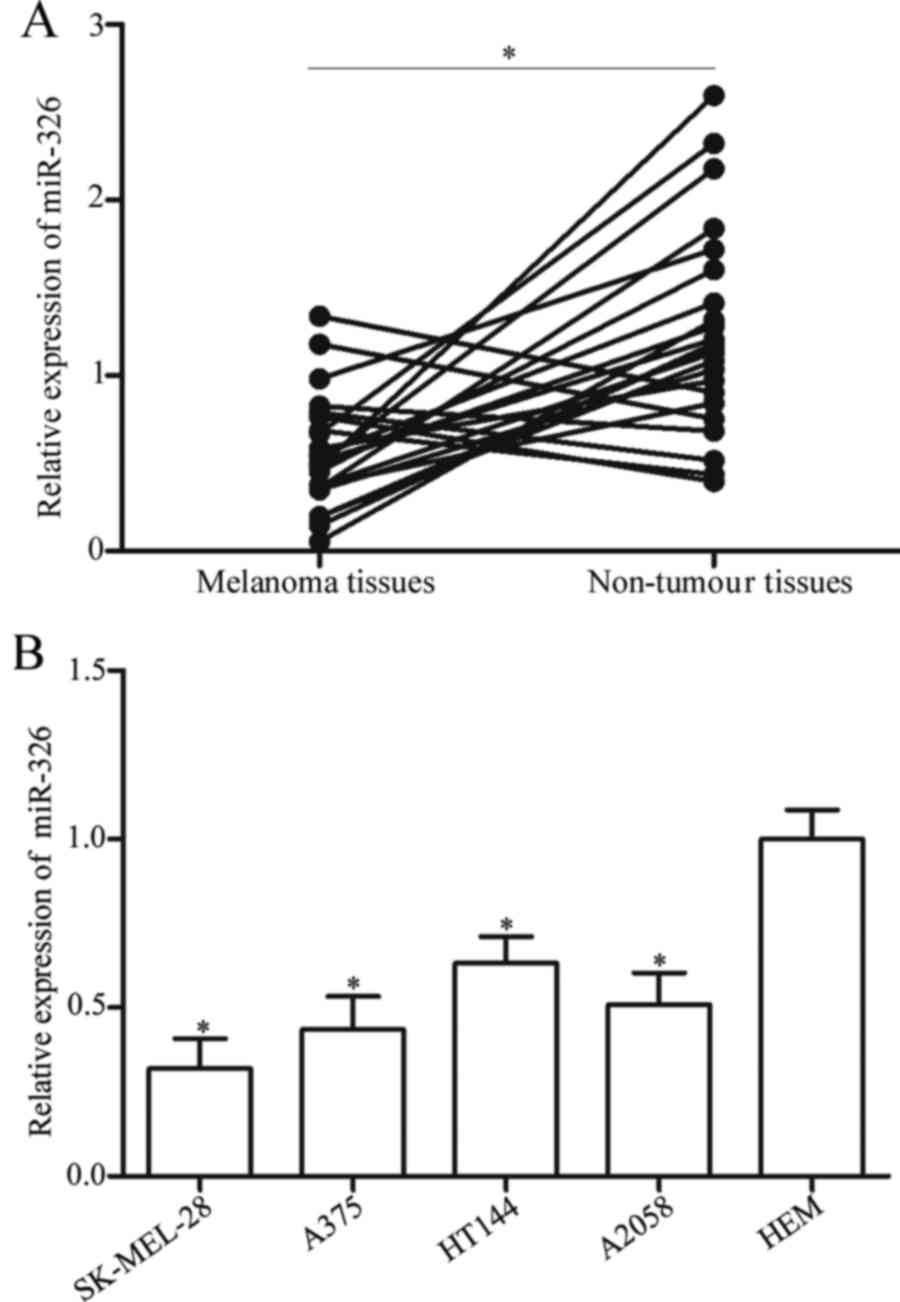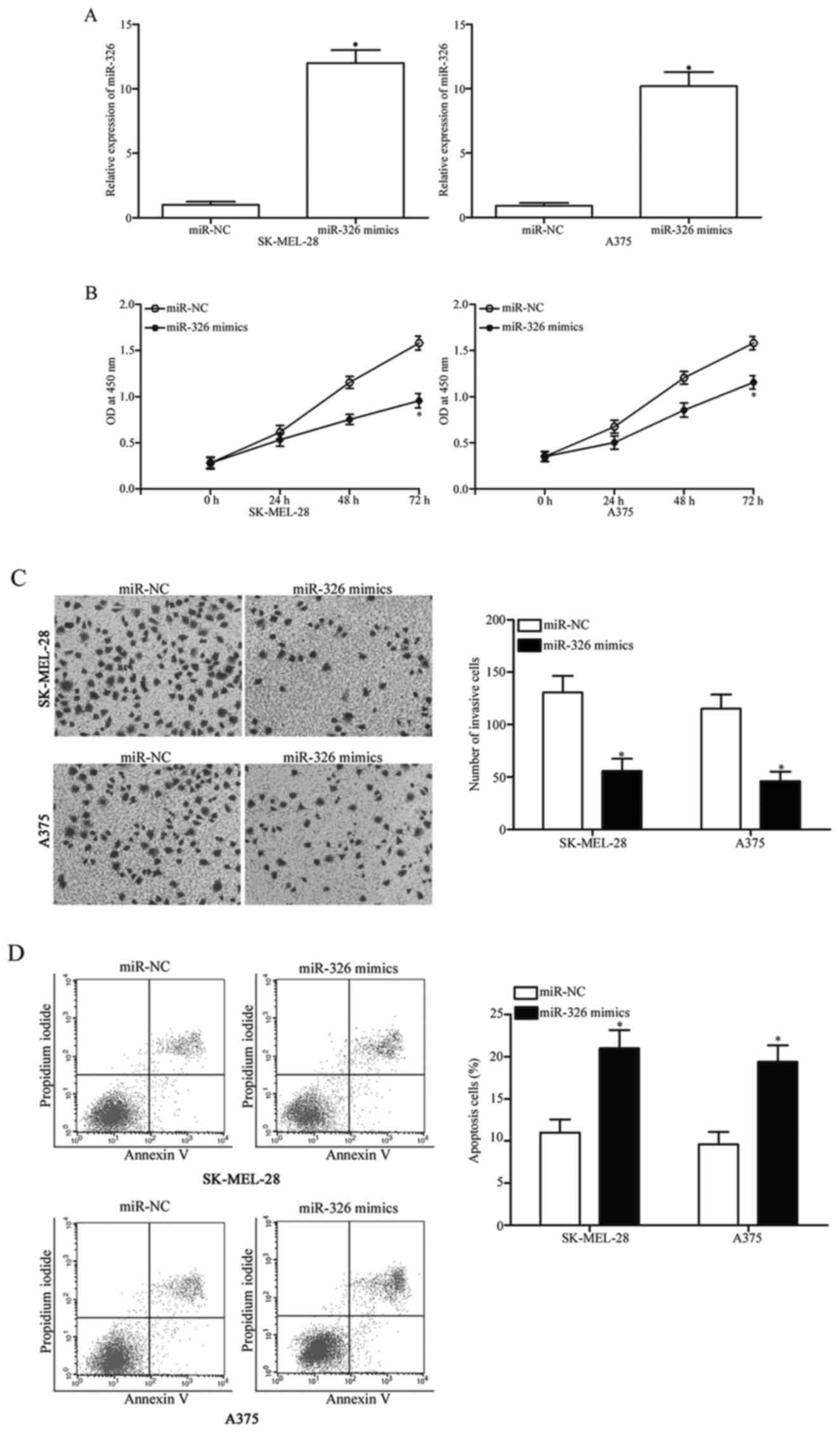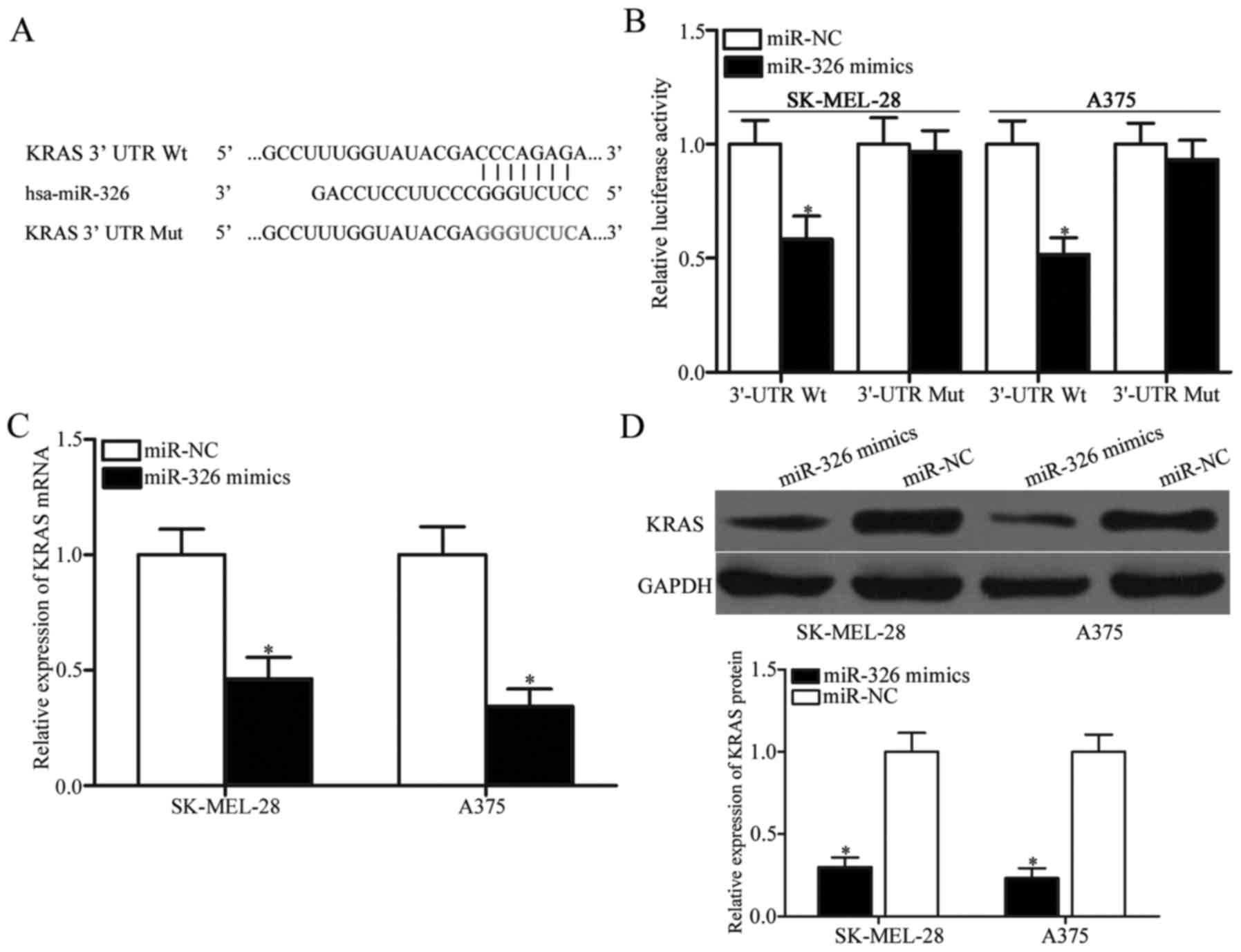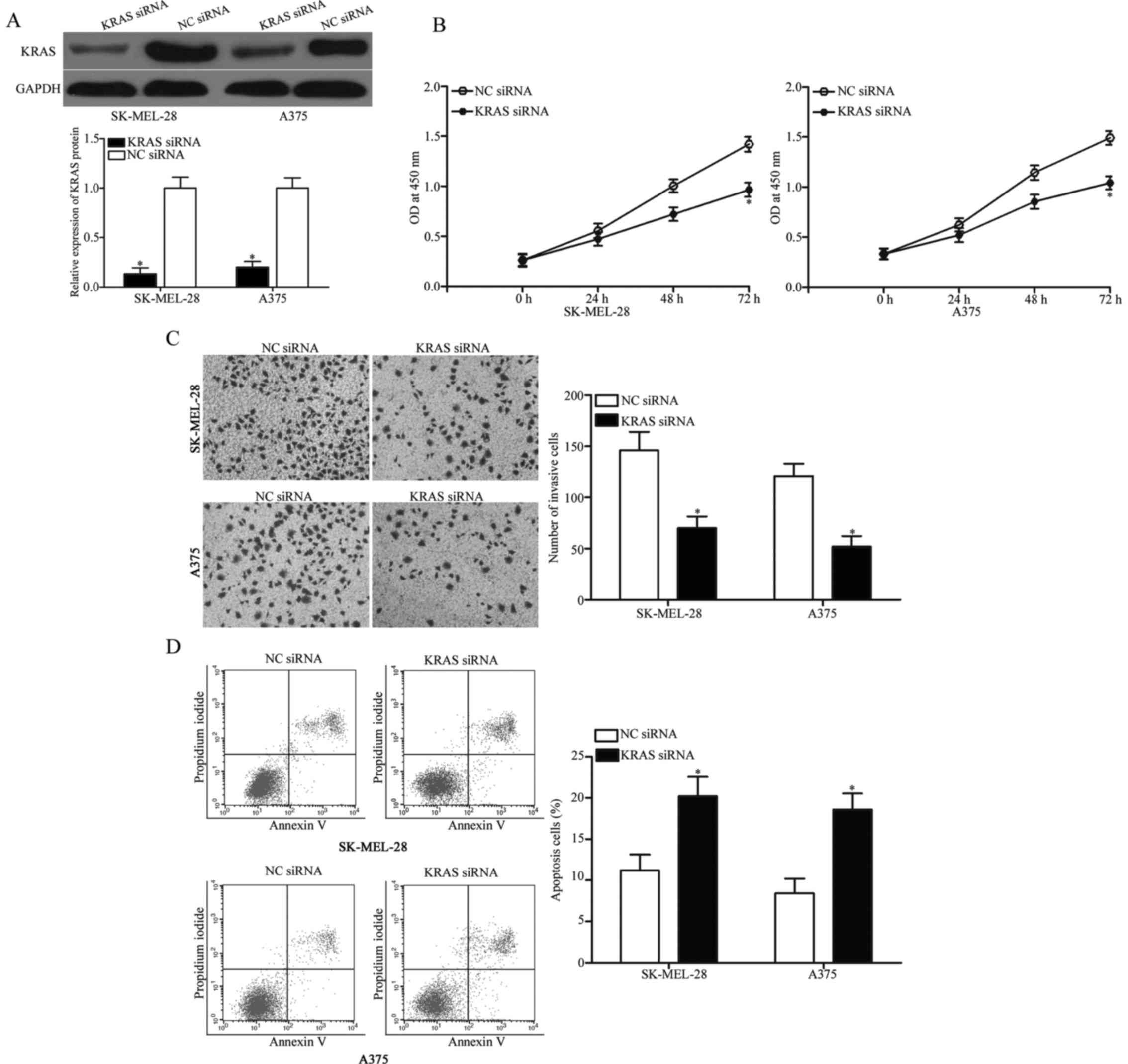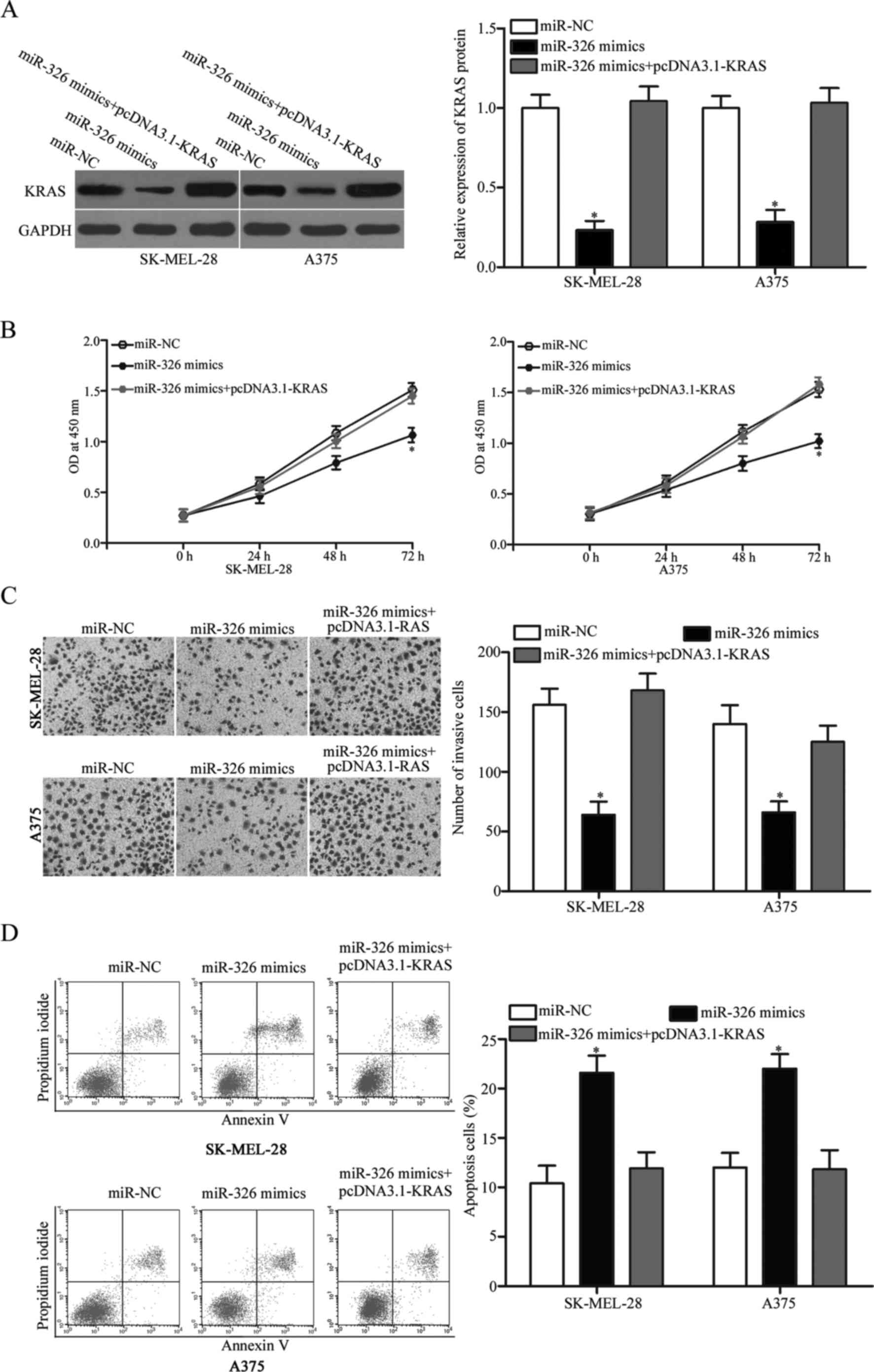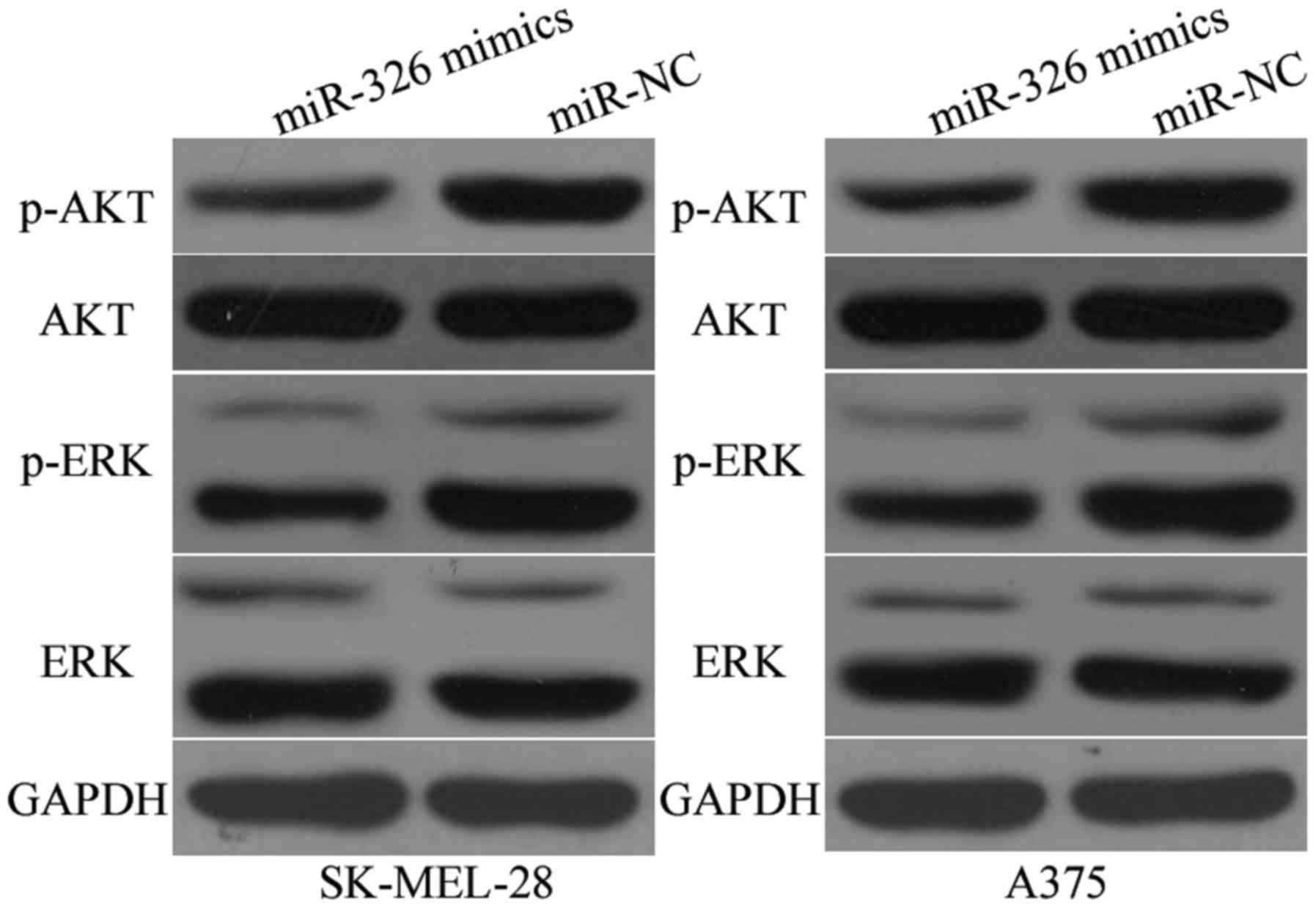MicroRNA-326 inhibits melanoma progression by targeting KRAS and suppressing the AKT and ERK signalling pathways
Retraction in: /10.3892/or.2023.8488
- Authors:
- Published online on: November 2, 2017 https://doi.org/10.3892/or.2017.6074
- Pages: 401-410
Abstract
Introduction
Melanoma, a tumour derived from melanocytes, is the seventh most common malignancy in females and the fifth most common cancer in males worldwide (1,2). It is characterised by aggressive invasion, early metastasis and resistance to chemotherapy or radiotherapy (3). Approximately 200,000 new cases and 46,000 deaths occur annually from the disease worldwide (4). Currently, the therapeutic management of melanoma patients consists mainly of surgical treatments and subsequent biotherapy, radiotherapy and chemotherapy (5). Melanoma cases diagnosed at an early stage can be curable with surgical resection. However, advanced melanomas with regional or distant metastases respond poorly to current treatment methods, resulting in high mortality rates (6). The prognosis for patients with local and distant metastases is poor, with a 10-year survival rate of 64 and 16%, respectively (7). Therefore, identifying the mechanisms underlying tumourigenesis and progression of melanoma is urgently needed in order to develop novel effective strategies for melanoma patients (8).
Over the past few years, microRNAs (miRNAs) have emerged as major regulators of the development of human cancers, including melanoma (9,10). miRNAs are a type of endogenous, noncoding and short RNAs with a length of ~22 nucleotides. miRNAs negatively modulate gene expression through imperfect base pairing with specific sequences in the 3′-untranslated regions (3′-UTRs) of their target genes, resulting in either mRNA degradation or translation inhibition (11). In total, more than 1,900 human miRNAs have been identified in the miRBase version 20.0 (http://www.mirbase.org/) and over 50% of all human protein-coding genes are regulated by miRNAs (12). Numerous studies have indicated that miRNAs play pivotal roles in several biological processes, including cell proliferation, cycle, apoptosis, differentiation, migration and metastasis (13–15). Recently, dysregulation of miRNA expression has been observed in various types of human cancers, such as melanoma (16), gastric (17), lung (18) and colorectal cancer (19) and glioma (20). In the context of cancer, miRNAs may serve as oncogenes or tumour suppressors in tumourigenesis and tumour development by negatively regulating tumour suppressors or oncogenes (21,22). Therefore, exploring the expression patterns and roles of miRNAs in melanoma may provide potential diagnostic and therapeutic targets for melanoma treatment.
Recently, miR-326 has been reported to be differentially expressed in various types of tissues and play important roles in tumourigenesis and tumour development (23–25). However, to the best of our knowledge, studies on the role of miR-326 in melanoma have not yet been conducted. Therefore, the present study aimed to detect the miR-326 expression and investigate the biological roles of miR-326 in melanoma, as well as its potential underlying mechanisms.
Materials and methods
Tissue specimens and cell lines
A total of 23 pairs of melanoma tissues and adjacent non-tumour tissues were collected from patients (male, 14; female, 9; age, 36–69 years; mean age, 52 years) at the Tangshan City Workers' Hospital between January 2013 and October 2015. All patients involved in this study were not treated with radiation therapy or chemotherapy prior to the surgical resection. These resected tissues were immediately frozen in liquid nitrogen and then stored at −80°C until use. The present study was approved by the Ethics Committee of the Institute of Tangshan City Workers' Hospital. In addition, informed consents were obtained from all subjects prior to the study.
Four human melanoma cell lines, namely SK-MEL-28, A375, HT144 and A2058, were acquired from the American Type Culture Collection (ATCC; Manassas, VA, USA) and maintained in Dulbecco's modified Eagle's medium (DMEM; Gibco; Thermo Fisher Scientific, Inc., Waltham, MA, USA) containing 10% foetal bovine serum (FBS; Gibco; Thermo Fisher Scientific), 100 mg/ml penicillin and 100 mg/ml streptomycin (Gibco; Thermo Fisher Scientific). Human epidermal melanocytes (HEMs) were purchased from ScienCell Research Laboratories, Inc. (San Diego, CA, USA) and cultured in melanocyte medium (ScienCell Research Laboratories) according to the manufacturer's protocol. All cells were grown in a humidified incubator at 37°C with 5% CO2.
Oligonucleotides and transfection
miR-326 mimics, miRNA negative control mimics (miR-NC), a small interfering RNA (siRNA) targeting KRAS (KRAS siRNA) and a negative control siRNA (NC siRNA) were obtained from Shanghai GenePharma Co., Ltd. (Shanghai, China). pcDNA3.1-KRAS plasmid and empty pcDNA3.1 plasmid were synthesised by GeneCopoeia (Guangzhou, China). The cells were transfected with miRNAs, siRNAs or plasmids using Lipofectamine 2000 (Invitrogen; Thermo Fisher Scientific) according to the manufacturer's instructions. The cell culture medium was replaced with fresh DMEM supplemented with 10% FBS at 6 h post-transfection.
Reverse transcription-quantitative polymerase chain reaction (RT-qPCR)
Total RNA samples were isolated from the tissues or the cells using TRIzol (Invitrogen; Thermo Fisher Scientific), according to the manufacturer's instructions. For the miR-326 detection, total RNA was reverse transcribed into cDNA using TaqMan MicroRNA Reverse Transcription kit (Applied Biosystems, Carlsbad, CA, USA) and qPCR was carried out with a TaqMan MicroRNA PCR kit (Applied Biosystems) on an ABI Prism 7500 Sequence Detection system (Applied Biosystems). To quantify KRAS mRNA, cDNA was synthesised using PrimeScript RT reagent kit (Takara Biotechnology Co., Ltd., Dalian, China), followed by qPCR with SYBR Premix Ex Taq™ (Takara Biotechnology). U6 and GAPDH were used as internal reference for miR-326 and KRAS, respectively. The relative levels of miRNA and mRNA were analysed via the 2−ΔΔCt method (26). The primers used in the present study were as follows: miR-326 forward, 5′-GGCGCCCAGAUAAUGCG-3′ and reverse, 5′-CGTGCAGGGTCCGAGGTC-3′; U6 forward, 5′-CTCGCTTCGGCAGCACATATACT-3′ and reverse, 5′-ACGCTTCACGAATTTGCGTGTC-3′; KRAS forward, 5′-GACTCTGAAGATGTACCTATGGTCCTA-3′ and reverse, 5′-CATCATCAACACCCTGTCTTGTC-3′; GAPDH forward, 5′-ATGGGTCAGAAGGATTCCTATGTG-3′ and reverse, 5′-CTTCATGAGGTAGTCAGTCAGGTC-3′.
Cell Counting Kit-8 (CCK8) assay
A CCK8 assay was used to assess melanoma cell proliferation. A total of 3×103 cells/well were seeded into 96-well plates. After being cultured overnight at 37°C, the cells were transfected with miRNAs, siRNAs or plasmids. The examination time-points were set at 0, 24, 48 and 72 h after transfection. In brief, 10 µl of CCK8 solution (Dojindo Laboratories, Kumamoto, Japan) was added to each well and the cells were incubated at 37°C with 5% CO2 for 2 h. A microplate reader (Bio-Tek Instruments, Inc., Winooski, VT, USA) was used to measure the optical density (OD) values at a wavelength of 450 nm. Each experimental group contained five replicate wells and this assay was repeated three times.
Cell invasion assay
The Transwell chambers coated with Matrigel (BD Biosciences, San Jose, CA, USA) on the upper surface of a polycarbonic membrane were used to perform cell invasion assays. A total of 1×105 transfected cells in FBS-free DMEM were placed in the upper chambers. The bottom chambers were filled with 500 µl of DMEM containing 20% FBS serving as a chemoattractant. After 24 h of incubation, the cells remaining on the upper surface of the membrane were removed using cotton swabs. The invasive cells were fixed in 90% alcohol, stained with 0.5% crystal violet, dried at 80°C for 30 min and photographed. The cell number was determined in five fields randomly selected under an inverted microscope (×200 magnification, IX73; Olympus Corporation, Tokyo, Japan). The experiments were performed in triplicates and repeated three times.
Flow cytometric analysis
At 48 h after transfection, the cells were collected via trypsinization, washed with ice-cold phosphate-buffered saline (PBS) and fixed in ice-cold 80% ethanol in PBS. Fluorescein isothiocyanate (FITC) Annexin V-apoptosis detection kit (BD Biosciences) was used to determine cell apoptosis rate according to the manufacturer's instructions. In brief, the fixed cells were treated with FITC Annexin V and propidium iodide (PI) for 20 min in the dark at room temperature. The cell apoptosis rate was assessed using FACScan flow cytometer (BD Biosciences, Franklin Lakes, NJ, USA) within 1 h of staining.
Bioinformatic analysis and luciferase reporter assay
Bioinformatic analysis was performed to predict the putative targets of miR-326 using TargetScan (www.targetscan.org) and miRBase (http://www.mirbase.org). KRAS was indicated as a potential target of miR-326.
For the luciferase activity assay, a wild-type and mutant 3′-UTR segment of KRAS cloned into a pmirGLO plasmid (pmirGLO-KRAS-3′-UTR Wt and pmirGLO-KRAS-3′-UTR Mut) was synthesised and confirmed by Shanghai GenePharma. The cells were seeded into 24-well plates at a density of 60–70% confluency and co-transfected with miR-326 mimics or miR-NC and pmirGLO-KRAS-3′-UTR Wt or pmirGLO-KRAS-3′-UTR Mut using Lipofectamine 2000. After incubation at 37°C for 48 h, the cells were harvested, and luciferase activity was assessed using the Dual-Luciferase Reporter assay system (Promega, Manheim, Germany) according to the manufacturer's protocol. Renilla luciferase activity served as an internal reference. The experiments were performed ≥3 times independently.
Protein isolation and western blot analysis
The protein was extracted from tissues or cells using radioimmunoprecipitation assay buffer (Nanjing KeyGen Biotech Co., Ltd., Nanjing, China) supplemented with a freshly added protease inhibitor cocktail (Roche, Manheim, Germany). After centrifuging at 16,000 × g at 4°C for 10 min, the protein concentration was detected using the Bicinchoninic Acid Protein Assay kit (Pierce; Thermo Fisher Scientific). Equal amounts of protein were dissolved using sodium dodecyl sulphate-polyacrylamide gel electrophoresis (SDS-PAGE) and transferred to polyvinylidene difluoride membranes (EMD Millipore, Billerica, MA, USA). After blocking with 5% nonfat milk in Tris-buffered saline, 0.1% Tween (TBST) at room temperature for 1 h, the membranes were incubated with primary antibodies at 4°C overnight. The primary antibodies used in this assay included mouse anti-human monoclonal KRAS (sc-30; 1:1,000 dilution; Santa Cruz Biotechnology, Santa Cruz, CA, USA), mouse anti-human monoclonal p-AKT (sc-81433; 1:1,000 dilution; Santa Cruz Biotechnology), mouse anti-human monoclonal AKT (sc-56878; 1:1,000 dilution; Santa Cruz Biotechnology), mouse anti-human monoclonal p-ERK (sc-81492; 1:1,000 dilution; Santa Cruz Biotechnology), mouse anti-human monoclonal ERK (sc-514302; 1:1,000 dilution; Santa Cruz Biotechnology), and mouse anti-human monoclonal GAPDH antibody (sc-32233; 1:1,000 dilution; Santa Cruz Biotechnology). The membranes were then washed three times with TBST for 5 min each time and further probed with goat anti-mouse horseradish peroxidase-conjugated secondary antibody (sc-2005; 1:5,000 dilution; Santa Cruz Biotechnology) at room temperature for 1 h. The signals were developed using an enhanced chemiluminescent reagent (Amersham Biosciences, Piscataway, NJ, USA). The signal intensity was determined using the FluorChem imaging system (Alpha-InnoTec GmbH, Kasendorf, Germany). GAPDH was used as a loading control.
Statistical analysis
The data were expressed as the mean ± standard deviation. All statistical analyses were performed via the Student's t-test or one-way ANOVA followed by Student-Newman-Keuls post hoc test, with SPSS 18.0 software (SPSS, Chicago, IL, USA). P<0.05 was considered to indicate a statistically significant difference.
Results
miR-326 is downregulated in melanoma tissues and cell lines
To explore the potential roles of miR-326 in melanoma, we firstly detected the expression levels of miR-326 in 23 pairs of melanoma tissues and adjacent non-tumour tissues. The RT-qPCR data revealed that miR-326 was weakly expressed in melanoma tissues compared with that in adjacent non-tumour tissues (Fig. 1A, P<0.05). Subsequently, the expression levels of miR-326 were determined in four melanoma cell lines, namely SK-MEL-28, A375, HT144 and A2058 as well as HEM, using RT-qPCR. The results revealed that miR-326 was significantly downregulated in melanoma cell lines compared with that in HEM (Fig. 1B, P<0.05). These findings indicated that miR-326 may contribute to melanoma development.
Upregulation of miR-326 inhibits the proliferation and invasion and promotes the apoptosis of melanoma cells
To assess the regulatory roles of miR-326 in melanoma, SK-MEL-28 and A375 melanoma cells, which exhibited a relatively weaker miR-326 expression, were transfected with miR-326 mimics or miR-NC. The RT-qPCR data indicated that the miR-326 expression was substantially upregulated in the SK-MEL-28 and A375 cells after transfection with miR-326 mimics, compared with cells transfected with miR-NC (Fig. 2A, P<0.05). The CCK8 assay was performed to evaluate the effect of miR-326 overexpression on melanoma cell proliferation. As illustrated in Fig. 2B, the restoration of the expression of miR-326 significantly suppressed the proliferation of the SK-MEL-28 and the A375 cells compared with the miR-NC group (Fig. 2B, P<0.05). To determine the role of miR-326 in the invasion capability of melanoma cells, cell invasion assays were conducted in the SK-MEL-28 and A375 cells transfected with miR-326 mimics or miR-NC. The results revealed that ectopic expression of miR-326 decreased the invasive capacities of the SK-MEL-28 and A375 cells (Fig. 2C, P<0.05). To examine the effect of miR-326 on the apoptosis of melanoma cells, flow cytometric analysis was performed. Our data demonstrated that miR-326 overexpression led to an increased rate of apoptosis in the SK-MEL-28 and A375 cells (Fig. 2D, P<0.05). Overall, these findings indicated that miR-326 exerts a suppressive role in melanoma progression.
KRAS is a direct target gene of miR-326 in melanoma
To investigate the underlying mechanism responsible for the miR-326-mediated tumour-suppressing roles in melanoma, the potential binding sites of miR-326 were determined using bioinformatic analysis. Of these target candidate genes, KRAS (Fig. 3A) attracted our attention immediately since it has been implicated in tumourigenesis and progression (27–29). To confirm this hypothesis, luciferase reporter assays were performed in SK-MEL-28 and A375 cells transfected with miR-326 mimics or miR-NC along with pmirGLO-KRAS-3′-UTR Wt or pmirGLO-KRAS-3′-UTR Mut. As displayed in Fig. 3B, miR-326 significantly decreased the luciferase activities of the 3′-UTR Wt (P<0.05), but not the 3′-UTR Mut of KRAS in the SK-MEL-28 and A375 cells. To further confirm whether KRAS is a direct target of miR-326, the effects of miR-326 overexpression on endogenous KRAS expression in melanoma cells were examined by RT-qPCR and western blot analysis. The results revealed that restoration of the expression of miR-326 suppressed the KRAS expression in the SK-MEL-28 and A375 cells at both the mRNA (Fig. 3C, P<0.05) and protein (Fig. 3D, P<0.05) levels. These results indicated that KRAS is a novel target of miR-326 in melanoma.
KRAS expression is inversely correlated with miR-326 levels in melanoma tissues
We further determined the expression levels of KRAS in 23 pairs of melanoma tissues and adjacent non-tumour tissues. The results revealed that KRAS mRNA was highly expressed in melanoma tissues compared with that in adjacent non-tumour tissues (Fig. 4A, P<0.05). In addition, a negative correlation between the miR-326 level and the KRAS level was observed in melanoma tissues (Fig. 4B, r=−0.6589, P<0.001), further indicating that the KRAS overexpression in melanoma is a result of the miR-326 underexpression. In addition, western blot analysis also revealed that the KRAS expression was upregulated in melanoma tissues compared with that in adjacent non-tumour tissues (Fig. 4C).
KRAS knockdown phenocopies the effects of miR-326 overexpression in melanoma cells
Considering that KRAS is a direct target of miR-326, we hypothesised that the tumour-suppressing roles of miR-326 in melanoma cells could be achieved by KRAS downregulation. To examine this hypothesis, we knocked down KRAS via RNA interference techniques to evaluate the biochemical roles of KRAS in melanoma. Western blot analysis confirmed that KRAS protein was significantly downregulated in the SK-MEL-28 and A375 cells after transfection with KRAS siRNA (Fig. 5A, P<0.05). Functional assays revealed that the downregulation of KRAS inhibited cell proliferation (Fig. 5B, P<0.05) and invasion (Fig. 5C, P<0.05) and promoted apoptosis (Fig. 5D, P<0.05) in the SK-MEL-28 and A375 cells. These results indicated that KRAS mediates the biological functions of miR-326 in melanoma.
KRAS restoration markedly abrogates the antitumour effects of miR-326 in melanoma
To determine whether miR-326 induces antitumour effects in melanoma cells by targeting KRAS, rescue experiments were performed. The SK-MEL-28 and A375 cells were transfected with miR-326 mimics with or without pcDNA3.1-KRAS. Western blot analysis revealed that decreased KRAS expression was markedly restored by transfection of pcDNA3.1-KRAS (Fig. 6A, P<0.05). Expectedly, the KRAS overexpression markedly reversed the miR-326-induced tumour suppressive effects in the SK-MEL-28 and A375 cells (Fig. 6B-D, P<0.05). These results demonstrated that miR-326 served as a tumour suppressor in melanoma, at least in part through the KRAS suppression.
MiR-326 suppresses the AKT and ERK signalling pathways in melanoma
Previous studies reported that KRAS activated the AKT and ERK signalling pathways (30,31). Subsequently, we examined whether the miR-326 upregulation could inhibit the AKT and ERK signalling pathways. As illustrated in Fig. 7, the miR-326 upregulation reduced the p-AKT (P<0.05) and p-ERK (P<0.05) expression in the SK-MEL-28 and A375 cells, however it had no significant effects on the AKT and ERK expression. These results indicated that miR-326 regulated the AKT and ERK signalling pathways in melanoma.
Discussion
An increasing number of studies have reported that miRNA dysregulation is frequently observed in various types of human cancers, including melanoma (32–34). Abnormally expressed miRNAs play an important role in melanoma formation and progression by serving as potential biomarkers and therapeutic targets (35–37). In the present study, we investigated the expression levels, the exact roles and the regulatory mechanism of miR-326 in melanoma. Our data revealed that miR-326 was significantly downregulated in melanoma tissues and cell lines. The enforced expression of miR-326 attenuated melanoma cell proliferation and invasion and increased apoptosis in vitro. KRAS was also validated as a novel target of miR-326 in melanoma. In addition, miR-326 inactivated the AKT and ERK signalling pathways in melanoma. These results indicated that miR-326 plays tumour-suppressive roles in melanoma by directly regulating KRAS and indirectly regulating the AKT and ERK signalling pathways.
Previous studies indicated that miR-326 is aberrantly expressed in some types of human cancer. For example, miR-326 expression is downregulated in osteosarcoma. The decreased miR-326 expression in osteosarcoma is significantly associated with distant metastasis and advanced clinical stage. In addition, osteosarcoma patients with a low miR-326 expression tend to have shorter survival time than patients with high miR-326 expression (38). Furthermore, miR-326 is expressed in low levels in gastric cancer and is strongly associated with clinical stage, tumour depth, lymph node metastasis and distant metastasis. In survival analysis, low miR-326 expression is a poor independent prognostic factor for gastric cancer patients (39). In glioma, miR-326 expression level is reduced in tumour tissues and cell lines. miR-326 expression level is correlated with advanced pathological grade and low Karnofsky performance score. In addition, low miR-326 expression is an independent factor predicting poor prognosis for glioma patients (40). Downregulation of miR-326 is also observed in colorectal (23), pancreatic (24) and lung cancer (25). Previous studies have indicated that miR-326 may be investigated as a useful prognostic marker in human cancer.
Numerous studies have reported that miR-326 contributes to the malignant phenotype of cancers. Cao et al (38) found that miR-326 overexpression inhibited the growth and metastasis of osteosarcoma cells. In addition, studies reported that the enforced expression of miR-326 suppressed gastric cancer (GC) cell growth and metastasis and induced GC cell G2/M arrest (39,41). Furthermore, studies revealed that miR-326 served as a tumour-suppressor in glioma by inhibiting cell proliferation, colony formation and metabolic activity and inducing cell apoptosis (42,43). Wu et al (23) reported that miR-326 re-expression attenuated cell growth and motility and promoted cell apoptosis and cell cycle-arrest in colorectal cancer. Studies revealed that miR-326 decreased cell proliferation, viability, colony formation, migration and invasion, reversed chemoresistance and increased apoptosis and epithelial-to-mesenchymal transition of lung cancer (25,44–46). These findings indicated that miR-326 could be developed as a therapeutic target for these human cancer types.
Several miR-326 targets, including Bcl-2 (38) in osteosarcoma, FSCN1 (39) and NOB1 (41) in gastric cancer, SMO (47) and PKM2 (43) in glioma and CCND1 (25), phox2a (44), SP1 (45) and ADAM17 (46) in lung cancer, have been identified. In the present study, KRAS was validated as a novel target of miR-326. The KRAS gene, located in 12p12.1, encodes a protein that is a member of the small GTPase superfamily (48). Recently, an abnormal KRAS expression has been reported to be involved in human cancers, such as gastric (27), pancreatic (28), bladder (29), lung (49) and breast cancer (50). In adittion, aberrantly expressed and somatic activating mutations in KRAS are involved in tumourigenesis and tumour development, including pilocytic astrocytoma (51), nasopharyngeal carcinoma (52), colorectal (53) and lung cancer (54). In the present study, we found that KRAS was highly expressed in melanoma at both the mRNA and protein levels. In addition, the KRAS downregulation inhibited melanoma cell proliferation and invasion and induced apoptosis. Previous studies indicated that KRAS activation triggered several downstream pathways, such as the PI3K/Akt and MAPK/ERK signalling pathways (55,56). Consistently, the present study demonstrated that miR-326 upregulation reduced the KRAS expression and inactivated the AKT and ERK signalling pathways. These findings indicated that miR-326 acts as a tumour suppressor in melanoma by targeting KRAS and regulating the AKT and ERK signalling pathways. Therefore, KRAS could be major target for potential cancer therapies and numerous therapeutic strategies for melanoma.
In conclusion, the present study provided evidence that miR-326 is downregulated in melanoma and is involved in melanoma carcinogenesis and progression, partly by directly targeting KRAS. Modulating the miR-326 expression represents a potential strategy for the treatment of melanoma patients.
References
|
Trotter SC, Sroa N, Winkelmann RR, Olencki T and Bechtel M: A global review of melanoma follow-up guidelines. J Clin Aesthet Dermatol. 6:18–26. 2013.PubMed/NCBI | |
|
Linos E, Swetter SM, Cockburn MG, Colditz GA and Clarke CA: Increasing burden of melanoma in the United States. J Invest Dermatol. 129:1666–1674. 2009. View Article : Google Scholar : PubMed/NCBI | |
|
Terando A, Sabel MS and Sondak VK: Melanoma: Adjuvant therapy and other treatment options. Curr Treat Options Oncol. 4:187–199. 2003. View Article : Google Scholar : PubMed/NCBI | |
|
Ferlay J, Soerjomataram I, Dikshit R, Eser S, Mathers C, Rebelo M, Parkin DM, Forman D and Bray F: Cancer incidence and mortality worldwide: Sources, methods and major patterns in GLOBOCAN 2012. Int J Cancer. 136:E359–E386. 2015. View Article : Google Scholar : PubMed/NCBI | |
|
Eggermont AM, Suciu S, Rutkowski P, Kruit WH, Punt CJ, Dummer R, Salès F, Keilholz U, de Schaetzen G and Testori A; EORTC Melanoma Group, : Long term follow up of the EORTC 18952 trial of adjuvant therapy in resected stage IIB-III cutaneous melanoma patients comparing intermediate doses of interferon-alpha-2b (IFN) with observation: Ulceration of primary is key determinant for IFN-sensitivity. Eur J Cancer. 55:111–121. 2016. View Article : Google Scholar : PubMed/NCBI | |
|
Eberle J, Kurbanov BM, Hossini AM, Trefzer U and Fecker LF: Overcoming apoptosis deficiency of melanoma-hope for new therapeutic approaches. Drug Resist Updat. 10:218–234. 2007. View Article : Google Scholar : PubMed/NCBI | |
|
Parkin DM, Bray F, Ferlay J and Pisani P: Global cancer statistics, 2002. CA Cancer J Clin. 55:74–108. 2005. View Article : Google Scholar : PubMed/NCBI | |
|
Mimeault M and Batra SK: Novel biomarkers and therapeutic targets for optimizing the therapeutic management of melanomas. World J Clin Oncol. 3:32–42. 2012. View Article : Google Scholar : PubMed/NCBI | |
|
Lelli D, Pedone C and Sahebkar A: Curcumin and treatment of melanoma: The potential role of microRNAs. Biomed Pharmacother. 88:832–834. 2017. View Article : Google Scholar : PubMed/NCBI | |
|
Calin GA and Croce CM: MicroRNA signatures in human cancers. Nat Rev Cancer. 6:857–866. 2006. View Article : Google Scholar : PubMed/NCBI | |
|
Filipowicz W, Bhattacharyya SN and Sonenberg N: Mechanisms of post-transcriptional regulation by microRNAs: Are the answers in sight? Nat Rev Genet. 9:102–114. 2008. View Article : Google Scholar : PubMed/NCBI | |
|
Kozomara A and Griffiths-Jones S: miRBase: Integrating microRNA annotation and deep-sequencing data. Nucleic Acids Res. 39(Database): D152–D157. 2011. View Article : Google Scholar : PubMed/NCBI | |
|
Yu X, Li Z and Liu J: MiRNAs in primary cutaneous lymphomas. Cell Prolif. 48:271–277. 2015. View Article : Google Scholar : PubMed/NCBI | |
|
Bai J, Zhang Z, Li X and Liu H: MicroRNA-365 inhibits growth, invasion and metastasis of malignant melanoma by targeting NRP1 expression. Int J Clin Exp Pathol. 8:4913–4922. 2015.PubMed/NCBI | |
|
Ren JW, Li ZJ and Tu C: MiR-135 post-transcriptionally regulates FOXO1 expression and promotes cell proliferation in human malignant melanoma cells. Int J Clin Exp Pathol. 8:6356–6366. 2015.PubMed/NCBI | |
|
Sun M, Wang X, Tu C, Wang S, Qu J and Xiao S: microRNA-216b inhibits cell proliferation and migration in human melanoma by targeting FOXM1 in vitro and in vivo. Cell Biol Int. Feb 22–2017.(Epub ahead of print). https://doi.org/10.1002/cbin.10754 View Article : Google Scholar | |
|
He L, Qu L, Wei L, Chen Y and Suo J: Reduction of miR 132 3p contributes to gastric cancer proliferation by targeting MUC13. Mol Med Rep. 15:3055–3061. 2017. View Article : Google Scholar : PubMed/NCBI | |
|
Yin Z, Xu M and Li P: miRNA-221 acts as an oncogenic role by directly targeting TIMP2 in non-small-cell lung carcinoma. Gene. 620:46–53. 2017. View Article : Google Scholar : PubMed/NCBI | |
|
Abdelmaksoud-Dammak R, Chamtouri N, Triki M, Saadallah-Kallel A, Ayadi W, Charfi S, Khabir A, Ayadi L, Sallemi-Boudawara T and Mokdad-Gargouri R: Overexpression of miR-10b in colorectal cancer patients: Correlation with TWIST-1 and E-cadherin expression. Tumour Biol. 39:10104283176959162017. View Article : Google Scholar : PubMed/NCBI | |
|
Zhu Y, Zhao H, Rao M and Xu S: MicroRNA-365 inhibits proliferation, migration and invasion of glioma by targeting PIK3R3. Oncol Rep. 37:2185–2192. 2017. View Article : Google Scholar : PubMed/NCBI | |
|
Shenouda SK and Alahari SK: MicroRNA function in cancer: Oncogene or a tumor suppressor? Cancer Metastasis Rev. 28:369–378. 2009. View Article : Google Scholar : PubMed/NCBI | |
|
Chen CZ: MicroRNAs as oncogenes and tumor suppressors. N Engl J Med. 353:1768–1771. 2005. View Article : Google Scholar : PubMed/NCBI | |
|
Wu L, Hui H, Wang LJ, Wang H, Liu QF and Han SX: MicroRNA-326 functions as a tumor suppressor in colorectal cancer by targeting the nin one binding protein. Oncol Rep. 33:2309–2318. 2015. View Article : Google Scholar : PubMed/NCBI | |
|
Zhang ZL, Bai ZH, Wang XB, Bai L, Miao F and Pei HH: miR-186 and 326 predict the prognosis of pancreatic ductal adenocarcinoma and affect the proliferation and migration of cancer cells. PLoS One. 10:e01188142015. View Article : Google Scholar : PubMed/NCBI | |
|
Sun C, Huang C, Li S, Yang C, Xi Y, Wang L, Zhang F, Fu Y and Li D: Hsa-miR-326 targets CCND1 and inhibits non-small cell lung cancer development. Oncotarget. 7:8341–8359. 2016. View Article : Google Scholar : PubMed/NCBI | |
|
Livak KJ and Schmittgen TD: Analysis of relative gene expression data using real-time quantitative PCR and the 2−ΔΔCt method. Methods. 25:402–408. 2001. View Article : Google Scholar : PubMed/NCBI | |
|
Li M, Liu W, Zhu YF, Chen YL, Zhang BZ and Wang R: Correlation of COX-2 and K-ras expression to clinical outcome in gastric cancer. Acta Oncol. 45:1115–1119. 2006. View Article : Google Scholar : PubMed/NCBI | |
|
Chang Z, Ju H, Ling J, Zhuang Z, Li Z, Wang H, Fleming JB, Freeman JW, Yu D, Huang P, et al: Cooperativity of oncogenic K-ras and downregulated p16/INK4A in human pancreatic tumorigenesis. PLoS One. 9:e1014522014. View Article : Google Scholar : PubMed/NCBI | |
|
Przybojewska B, Jagiello A and Jalmuzna P: H-RAS, K-RAS, and N-RAS gene activation in human bladder cancers. Cancer Genet Cytogenet. 121:73–77. 2000. View Article : Google Scholar : PubMed/NCBI | |
|
Hubbard PA, Moody CL and Murali R: Allosteric modulation of Ras and the PI3K/AKT/mTOR pathway: Emerging therapeutic opportunities. Front Physiol. 5:4782014. View Article : Google Scholar : PubMed/NCBI | |
|
Calvo F, Agudo-Ibáñez L and Crespo P: The Ras-ERK pathway: Understanding site-specific signaling provides hope of new anti-tumor therapies. BioEssays. 32:412–421. 2010. View Article : Google Scholar : PubMed/NCBI | |
|
Latchana N, Ganju A, Howard JH and Carson WE III: MicroRNA dysregulation in melanoma. Surg Oncol. 25:184–189. 2016. View Article : Google Scholar : PubMed/NCBI | |
|
Cui L, Li Y, Lv X, Li J, Wang X, Lei Z and Li X: Expression of MicroRNA-301a and its functional roles in malignant melanoma. Cell Physiol Biochem. 40:230–244. 2016. View Article : Google Scholar : PubMed/NCBI | |
|
Wozniak M, Mielczarek A and Czyz M: miRNAs in melanoma: tumor suppressors and oncogenes with prognostic potential. Curr Med Chem. 23:3136–3153. 2016. View Article : Google Scholar : PubMed/NCBI | |
|
Varamo C, Occelli M, Vivenza D, Merlano M and Lo Nigro C: MicroRNAs role as potential biomarkers and key regulators in melanoma. Genes Chromosomes Cancer. 56:3–10. 2017. View Article : Google Scholar : PubMed/NCBI | |
|
Wu J, Li J, Ren J and Zhang D: MicroRNA-485-5p represses melanoma cell invasion and proliferation by suppressing Frizzled7. Biomed Pharmacother. 90:303–310. 2017. View Article : Google Scholar : PubMed/NCBI | |
|
Luan W, Qian Y, Ni X, Bu X, Xia Y, Wang J, Ruan H, Ma S and Xu B: miR-204-5p acts as a tumor suppressor by targeting matrix metalloproteinases-9 and B-cell lymphoma-2 in malignant melanoma. Onco Targets Ther. 10:1237–1246. 2017. View Article : Google Scholar : PubMed/NCBI | |
|
Cao L, Wang J and Wang PQ: MiR-326 is a diagnostic biomarker and regulates cell survival and apoptosis by targeting Bcl-2 in osteosarcoma. Biomed Pharmacother. 84:828–835. 2016. View Article : Google Scholar : PubMed/NCBI | |
|
Li Y, Gao Y, Xu Y, Ma H and Yang M: Down-regulation of miR-326 is associated with poor prognosis and promotes growth and metastasis by targeting FSCN1 in gastric cancer. Growth Factors. 33:267–274. 2015. View Article : Google Scholar : PubMed/NCBI | |
|
Wang S, Lu S, Geng S, Ma S, Liang Z and Jiao B: Expression and clinical significance of microRNA-326 in human glioma miR-326 expression in glioma. Med Oncol. 30:3732013. View Article : Google Scholar : PubMed/NCBI | |
|
Ji S, Zhang B, Kong Y, Ma F and Hua Y: miR-326 inhibits gastric cancer cell growth through down regulating NOB1. Oncol Res. 25:853–861. 2017. View Article : Google Scholar : PubMed/NCBI | |
|
Zhou J, Xu T, Yan Y, Qin R, Wang H, Zhang X, Huang Y, Wang Y, Lu Y, Fu D, et al: MicroRNA-326 functions as a tumor suppressor in glioma by targeting the Nin one binding protein (NOB1). PLoS One. 8:e684692013. View Article : Google Scholar : PubMed/NCBI | |
|
Kefas B, Comeau L, Erdle N, Montgomery E, Amos S and Purow B: Pyruvate kinase M2 is a target of the tumor-suppressive microRNA-326 and regulates the survival of glioma cells. Neuro Oncol. 12:1102–1112. 2010. View Article : Google Scholar : PubMed/NCBI | |
|
Wang R, Chen X, Xu T, Xia R, Han L, Chen W, De W and Shu Y: miR-326 regulates cell proliferation and migration in lung cancer by targeting phox2a and is regulated by HOTAIR. Am J Cancer Res. 6:173–186. 2016.PubMed/NCBI | |
|
Li J, Li S, Chen Z, Wang J, Chen Y, Xu Z, Jin M and Yu W: miR-326 reverses chemoresistance in human lung adenocarcinoma cells by targeting specificity protein 1. Tumour Biol. 37:13287–13294. 2016. View Article : Google Scholar : PubMed/NCBI | |
|
Cai M, Wang Z, Zhang J, Zhou H, Jin L, Bai R and Weng Y: Adam17, a target of mir-326, promotes EMT-induced cells invasion in lung adenocarcinoma. Cell Physiol Biochem. 36:1175–1185. 2015. View Article : Google Scholar : PubMed/NCBI | |
|
Du W, Liu X, Chen L, Dou Z, Lei X, Chang L, Cai J, Cui Y, Yang D, Sun Y, et al: Targeting the SMO oncogene by miR-326 inhibits glioma biological behaviors and stemness. Neuro Oncol. 17:243–253. 2015. View Article : Google Scholar : PubMed/NCBI | |
|
Janssen KP, Alberici P, Fsihi H, Gaspar C, Breukel C, Franken P, Rosty C, Abal M, El Marjou F, Smits R, et al: APC and oncogenic KRAS are synergistic in enhancing Wnt signaling in intestinal tumor formation and progression. Gastroenterology. 131:1096–1109. 2006. View Article : Google Scholar : PubMed/NCBI | |
|
de Mello RA, Marques DS, Medeiros R and Araújo AM: Epidermal growth factor receptor and K-Ras in non-small cell lung cancer-molecular pathways involved and targeted therapies. World J Clin Oncol. 2:367–376. 2011. View Article : Google Scholar : PubMed/NCBI | |
|
Kim RK, Suh Y, Yoo KC, Cui YH, Kim H, Kim MJ, Gyu Kim I and Lee SJ: Activation of KRAS promotes the mesenchymal features of basal-type breast cancer. Exp Mol Med. 47:e1372015. View Article : Google Scholar : PubMed/NCBI | |
|
Ryu MJ, Liu Y, Zhong X, Du J, Peterson N, Kong G, Li H, Wang J, Salamat S, Chang Q, et al: Oncogenic Kras expression in postmitotic neurons leads to S100A8-S100A9 protein overexpression and gliosis. J Biol Chem. 287:22948–22958. 2012. View Article : Google Scholar : PubMed/NCBI | |
|
Deng M, Tang H, Zhou Y, Zhou M, Xiong W, Zheng Y, Ye Q, Zeng X, Liao Q, Guo X, et al: miR-216b suppresses tumor growth and invasion by targeting KRAS in nasopharyngeal carcinoma. J Cell Sci. 124:2997–3005. 2011. View Article : Google Scholar : PubMed/NCBI | |
|
Lièvre A, Bachet JB, Le Corre D, Boige V, Landi B, Emile JF, Côté JF, Tomasic G, Penna C, Ducreux M, et al: KRAS mutation status is predictive of response to cetuximab therapy in colorectal cancer. Cancer Res. 66:3992–3995. 2006. View Article : Google Scholar : PubMed/NCBI | |
|
Bhattacharya S, Socinski MA and Burns TF: KRAS mutant lung cancer: Progress thus far on an elusive therapeutic target. Clin Transl Med. 4:352015. View Article : Google Scholar : PubMed/NCBI | |
|
Schubbert S, Shannon K and Bollag G: Hyperactive Ras in developmental disorders and cancer. Nat Rev Cancer. 7:295–308. 2007. View Article : Google Scholar : PubMed/NCBI | |
|
Bodemann BO and White MA: Ral GTPases and cancer: Linchpin support of the tumorigenic platform. Nat Rev Cancer. 8:133–140. 2008. View Article : Google Scholar : PubMed/NCBI |



